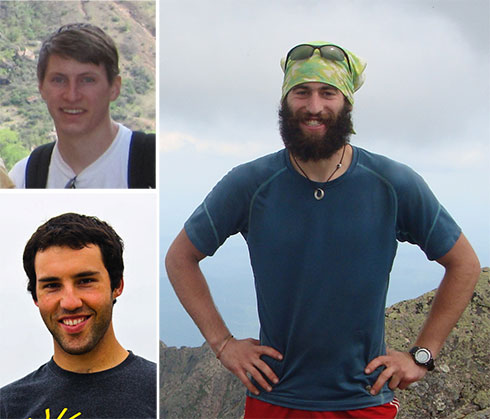NSE graduate students Black, Boyd, Shaner win NEUP Fellowships

First-year graduate students Brad Black, William Boyd and Samuel Shaner in the Department of Nuclear Science and Engineering at MIT are among 31 graduate students across the country who have won fellowships through the Department of Energy’s Nuclear Energy University Programs (NEUP).
Brad Black is working with Professor Ron Ballinger on the development of a probabilistic model for the lifetime of spent fuel storage canisters. With the cancellation of the Yucca Mountain Nuclear Waste Repository, spent nuclear fuel is being held indefinitely in storage canisters across the country. At present there is no good way to predict the life and durability of these canisters. Black’s research will be focused on studying the salt-rich environments of the various sites and on their potential to initiate stress corrosion cracking, particularly in the heat-affected zones of welds. “The goal,” says Black, “is to develop a model of the time to canister failure based on environmental, electrochemical, and material parameters, with minimal uncertainty, in order to provide guidance to future research and policy decisions.”
William Robert Dawson Boyd III has been working with Professor Kord Smith on the development of a deterministic neutron transport code, OpenMOC, which implements the method-of-characteristics. The goal is to use the code as a framework to develop, deploy, and analyze new acceleration techniques for neutron transport calculations. In particular, Boyd is working on an implementation of a graphics processing unit (GPU) accelerated version of OpenMOC. This new code will make use of the massively parallel hardware available through GPUs which are becoming increasingly pervasive in today's personal computers and workstations.
Samuel Shaner works with Professors Kord Smith and Benoit Forget in the rapidly growing field of computational modeling in nuclear engineering. “My interests lie in computational modeling of fully coupled neutronic and thermomechanical processes” says Shaner. Due to the inherently multidisciplinary nature of such problems and the complexity of coupling fundamentally different processes, current analysis has been limited to simplified physical representations. These simulations are crucial to demonstrating the safety of nuclear reactors and accurately modeling material behavior.
The DOE’s NEUP fellowships provide students with financial support to pursue a degree in the nuclear field and gain the skills and experiences they need to succeed in a nuclear science and engineering career. Each fellow will receive $50,000 annually over the next three years in addition to a summer internship at a National Laboratory. The selected students will study a range of critical nuclear energy issues, from fuel cycle sustainability to reactor efficiency and design.
"The NEUP fellowships are awarded competitively, so winning one is a honor that reflects positively on the winners as well as on MIT,” says NSE Professor Jacopo Buongiorno. “Moreover, these fellowships provide the students with a certain degree of freedom in selecting a research project."
A fourth student, Geoffrey Gunow, who will enroll in NSE at MIT in September, was awarded a NEUP fellowship while still a student at the University of Michigan. Gunow hopes to bring his fellowship with him to continue his studies in reactor physics and advanced computational methods at MIT.
Related
- MIT awarded over $1.7M in DOE Nuclear Energy University Programs grants
- New NSE strategy strengthens core, opens boundaries; seeks better integration of technical and societal issues
- New NSE faculty drive curriculum expansion into computational science and engineering
- NSE student award winners
- Energy Department Announces New Investments to Train Next Generation of Nuclear Energy Leaders, Advance University-Led Nuclear Innovation
Photos
top left: Brad Black
bottom left: Samuel Shaner
right: William Dawson
